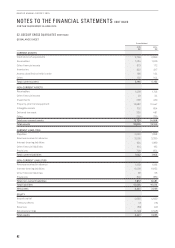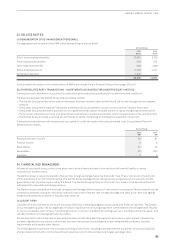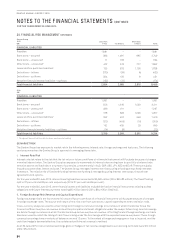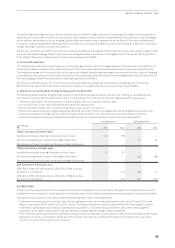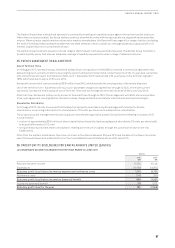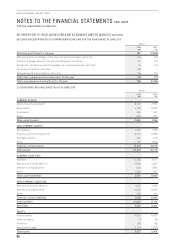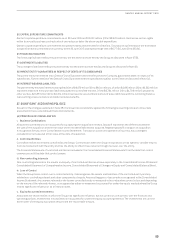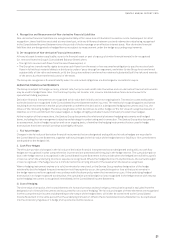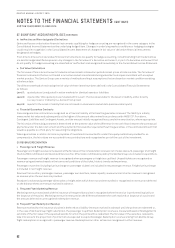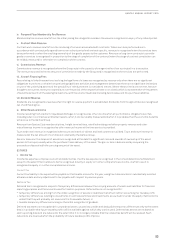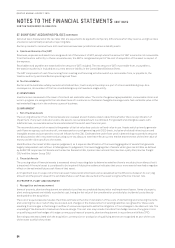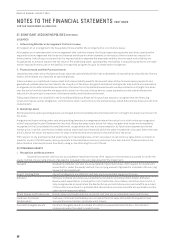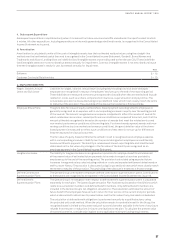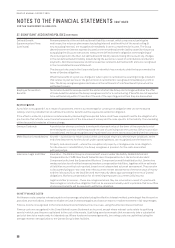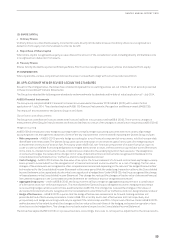Qantas 2015 Annual Report Download - page 93
Download and view the complete annual report
Please find page 93 of the 2015 Qantas annual report below. You can navigate through the pages in the report by either clicking on the pages listed below, or by using the keyword search tool below to find specific information within the annual report.
NOTES TO THE FINANCIAL STATEMENTS CONTINUED
FOR THE YEAR ENDED 30 JUNE 2015
92
QANTAS ANNUAL REPORT 2015
37. SIGNIFICANT ACCOUNTING POLICIES CONTINUED
iv. Ineffective and Non-designated Derivatives
Gains and losses on derivative financial instruments qualifying for hedge accounting are recognised in the same category in the
Consolidated Income Statement as the underlying hedged item. Changes in underlying market conditions or hedging strategies
could result in recognition in the Consolidated Income Statement of changes in fair value of derivative financial instruments
designated as hedges.
From time to time certain derivative financial instruments do not qualify for hedge accounting, notwithstanding that the derivatives
are held to hedge identified exposures. Any changes in the fair value of a derivative instrument, or part of a derivative instrument that
do not qualify for hedge accounting are classified as ‘ineffective’ and recognised immediately in the Consolidated Income Statement.
v. Fair Value Calculations
The fair value of financial instruments traded in active markets is based on quoted market prices at balance date. The fair value of
financial instruments that are not traded in an active market are estimated using valuation techniques consistent with accepted
market practice. The Qantas Group uses a variety of methods and input assumptions that are based on market conditions existing
atbalance date.
The different methods of estimating the fair value of these items have been defined in the Consolidated Financial Statements
as follows:
Level 1: quoted prices (unadjusted) in active markets for identical assets or liabilities
Level 2: inputs other than quoted prices included within Level 1 that are observable for the asset or liability, either directly
(i.e.asprices) or indirectly (i.e. derived from prices)
Level 3: inputs for the asset or liability that are not based on observable market data (unobservable inputs)
vi. Financial Guarantee Contracts
Financial guarantee contracts are recognised as a financial liability at the time the guarantee is issued. The liability is initially
measured at fair value and subsequently at the higher of the amount determined in accordance with AASB 137: Provisions,
Contingent Liabilities and Contingent Assets, and the amount initially recognised less cumulative amortisation, where appropriate.
The fair value of financial guarantees is determined as the present value of the difference in net cash flows between the contractual
payments under the debt instrument and the payments that would be required without the guarantee, or the estimated amount that
would be payable to a third party for assuming the obligations.
Where guarantees in relation to loans or payables of investments accounted for under the equity method are provided for no
compensation, thefair values are accounted for as contributions and recognised as part of the cost of the investment.
(D) REVENUE RECOGNITION
i. Passenger and Freight Revenue
Passenger and freight revenue is measured at the fair value of the consideration received, net of sales discount, passenger and freight
interline/IATA commission and Goods and Services Tax. Other sales commissions paid by the Qantas Group are included in expenditure.
Passenger revenue and freight revenue is recognised when passengers or freight are uplifted. Unused tickets are recognised as
revenue using estimates based on the terms and conditions of the ticket, historic trends and experience.
Passenger recoveries (including fuel surcharge on passenger tickets) are included in net passenger revenue. Freight fuel surcharge
isincluded in net freight revenue.
Revenue from ancillary passenger revenue, passenger services fees, lease capacity revenue and air charter revenue is recognised
asrevenue when the services are provided.
Receipts for advanced passenger ticket sales or freight sales which have not yet been availed or recognised as revenue are deferred
on the balance sheet as revenue received in advance.
ii. Frequent Flyer Marketing Revenue
Marketing revenue associated with the issuance of frequent flyer points is recognised when the service is performed (typically on
theissuance of the point). Marketing revenue is measured as the difference between the cash received on issuance of a point and
theamount deferred as unrecognised redemption revenue.
iii. Frequent Flyer Redemption Revenue
Revenue received for the issuance of points is deferred as a liability (revenue received in advance) until the points are redeemed or,
in the case of Qantas Group flight redemption, the passenger is uplifted. Redemption revenue is measured based on Management’s
estimate of the fair value of the expected awards for which the points will be redeemed. The fair value of the awards is reduced to
take into account the proportion of points that are expected to expire (breakage). Redemption revenue arising from Qantas Group
flight redemptions is recognised in passenger revenue. Redemptions on other airlines are recognised in other revenue.


